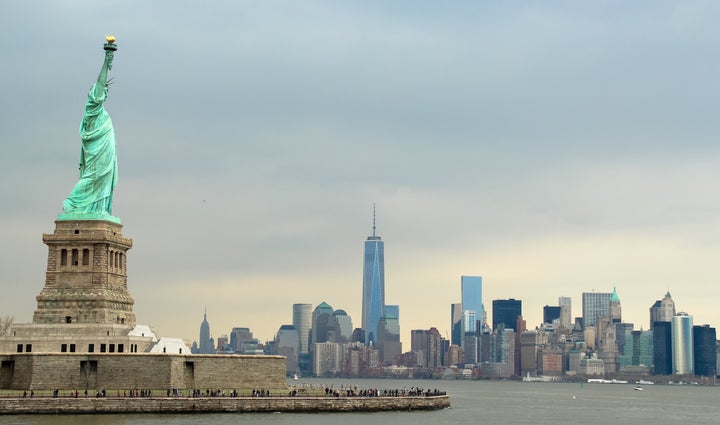
Imagine Theresa May and Jeremy Corbyn having such a row in the Commons that it led to hundreds of thousands of public sector workers being told to go home without any pay.
On top of this, these temporarily jobless people would have fewer options of how to pass their time – as all government-funded parks and museums would also be closed.
It seems far-fetched, but in the US it’s happening now – and not for the first time. A partial government shutdown came into effect after funding expired when the clock struck midnight on Saturday – and it’s not clear when it will end.
It’s so serious President Trump has made a big deal of the fact he is staying at the White House to work rather than go and play golf at his resort in Florida.
What is a government shutdown?
Pretty much exactly what it sounds like – the closing of (some) government agencies and federally controlled buildings and sites.
Those deemed “essential” are spared but employees of the rest (around 40%) are placed on unpaid leave and told not to work.
A shutdown results from an impasse in the US government when Republicans and Democrats can’t agree on what should be included in the latest spending bill.
What’s it all about?
Essentially, it all boils down to Trump’s much-vaunted US-Mexico border wall that Trump says is essential to stop illegal immigration.
The President wants a whopping $5billion (£3.95bn) to help fund it, but the Democratic opposition has only offered $1.3 billion (£1bn).
Until they can agree on a compromise, the shutdown will continue.
Despite the disruption, Trump has appeared to savour the prospect of a shutdown over the wall for months.
Last week he said he would be “proud” to close down the government.

So how long will it last?
No one really knows, and no one really seems in a rush to get it sorted out.
Rather than work around the clock to try to end the shutdown, as they had done in the past, the leaders of the House and the Senate effectively closed up shop.
But they did not rule out action if a deal were struck.
“Listen, anything can happen,” Senate Majority Leader Mitch McConnell told reporters after he closed the senate’s rare Saturday session hours after it opened.
But Trump’s budget director and chief of staff on Sunday said it could continue to January 3, when the new Congress convenes and Democrats take over the house of representatives.
“It’s very possible this shutdown will go beyond (December) the 28th and into the new Congress,” Mick Mulvaney said on Fox News Sunday.
“I don’t think things are going to move very quickly here for the next few days,” because of the Christmas holiday, added Mulvaney, who serves as director of the office of management and budget and was named acting White House chief of staff 10 days ago.
What has actually shut down?
Well let’s start with what hasn’t:
- Social Security cheques will still go out
- Troops will remain at their posts
- Doctors and hospitals will receive their Medicare and Medicaid reimbursements
In fact, virtually every essential US government agency, like the FBI, the border patrol and the coast guard, will remain open. Transportation security administration officers will continue to staff airport checkpoints.
But...
According to a report by Democrats on the senate appropriations committee, more than 420,000 federal employees deemed essential would continue to work without pay during a partial shutdown, including about 41,000 law enforcement and corrections officers and nearly 150,000 Homeland Security employees.
Those working without pay – three days before Christmas – would include about 53,000 Transportation Security Administration workers, 54,000 customs and border protection agents and officers and 42,000 coast guard employees.
As many as 5,000 forest service firefighters and 3,600 National Weather Service employees would also continue working, with the expectation that they will be paid back in full once the government reopens.
Meanwhile, more than 380,000 employees will be furloughed – including nearly all of Nasa and Housing and Urban Development and 41,000 Commerce Department employees.

About 16,000 National Park Service employees – 80% of the agency’s workforce – would also be placed on temporary leave of absence, and many parks would close. Some parks are already closed for the winter.
Among those set to be furloughed: 52,000 staffers at the Internal Revenue Service, slowing analysis and collection of hundreds of thousands of tax returns and audits.
Washington Monument and many other attractions would close, as would museums along the National Mall.
In the past, the vast majority of national parks were closed to visitors and campers, but during the last government shutdown in January the interior department tried to make parks as accessible as possible despite bare-bones staffing levels. It is not clear if that effort will be repeated.
Interior secretary Ryan Zinke, who greeted visitors at the Second World War memorial and other sites in Washington during the last shutdown, said he is stepping down at the end of the year.
So they won’t get paid at all?
Federal workers cannot be paid for days worked while there is a lapse in funding. In the past, however, they have been repaid retroactively even if they were ordered to stay at home.
Has this always been the way?
US government shutdowns were not too big a deal in previous administrations. They happened every year when Jimmy Carter was president, averaging 11 days each.
During Ronald Reagan’s two terms, there were six shutdowns, typically lasting just one or two days apiece. Deals were cut, and everyone moved on.
Before a three-day lapse in January, caused by Democrats’ insistence that any budget measure come with protections for young immigrants known as “dreamers”, the most recent significant shutdown was a 16-day partial closure of the government in 2013.
What are the long-term effects?
In a 1995-96 political battle, Democratic president Bill Clinton bested Speaker Newt Gingrich and his band of budget-slashing conservatives, who were determined to use a shutdown to force Clinton to sign onto a balanced budget agreement.
Republicans were saddled with the blame, but most Americans suffered relatively minor inconveniences like closed parks and delays in processing passport applications. The fight bolstered Clinton’s popularity and he sailed to re-election that November.
In 2013, the Tea Party Republicans forced the shutdown over the better judgment of GOP leaders like Speaker John Boehner. Republicans tried to fund the government piecemeal, but a broader effort faltered. Republicans eventually backed down and supported a round of budget talks led by Paul Ryan, who was then the House budget committee chairman.
Now, as House speaker himself, Ryan is struggling to head off a shutdown just days before his long-announced retirement.
Democrats, led by California representative Nancy Pelosi, will take over the House on January 3.
